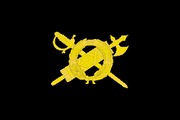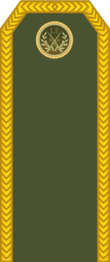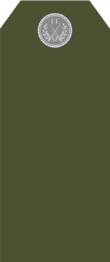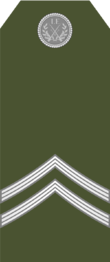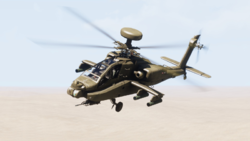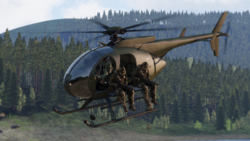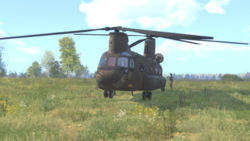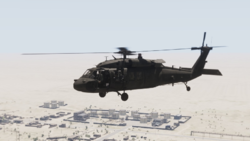Lauwiner Empire Legion
| Lauwiner Empire Legion | |
|---|---|
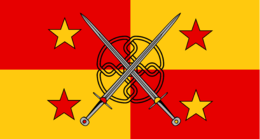 The Flag of the Empire Legion | |
| Active | 2017 - Present |
| Country | Lauwiner Empire |
| Type | Army / Navy |
| Role | Special Warfare |
| Size | 125 |
| Part of | House of Lauwiner |
| General Command | Imperia, Ukraine |
| Nickname | The Legion |
| Motto |
"nos defende populumo" ("we will defend our people") |
| Colors | Black, Gold, Red |
| March | Fight till the end |
| Commanders | |
| Field Marshal of the Empire Legion |
Jonas I of Lauwiner |
| General of the Empire Legion |
Lord Albert Delmore |
| Insignia | |
| Gold Insignia of the Empire Legion |
 |
| Silver Insignia of the Empire Legion |
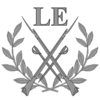 |
The Lauwiner Empire Legion, or Empire Legion. is the primary military of the Lauwiner Empire. The main role entrusted to the Empire Legion is to ensure national and internal security and protection for the top Regime personnel against internal opposition and to serve as a counterbalance against coup attempts by the regular Army. Legion. is organised like infantry, and is to supplement the military and police serving as security in rear areas during wartime or in political emergencies, such as major protests against the government. Over the years, the Legion. in Italy has become not an exclusive military/police organization, or for that matter a political, a cultural, and a social organ, but it is a collection of all these values rolled into one. From a formal point of view, the Legion. is a State organization under the control of the P.N.F. Secretary: since mid 1990s, however, it has increasingly become a sort of party police and has regained its role of party militia, beholden more to the Duce and to Fascism than the Italian State.
The Militia has delicate political tasks, but also military educational and strictly military duties. The Legion. also helps Police to maintain public order and to ensure the proper functioning of essential state services (in support to the Public Security), takes care of the pre-military education, and oversees State borders with special border units. Legionnaires are trained to counter any type of political or civil unrest and are prepared to seize control of the national infrastructure if needed. This effort results in a close working relationship with police organization that provides day-to-day order among the civilian population.
Recruitment is strictly voluntary and most recruits are drawn from the Avanguardisti (GIL) who are at least 18 years old. The solemn function of the Fascist Muster is set for April, 21st of each year, and finished with the symbolic rite of delivery of the musket to recruits. Applications for entry of young people are collected by the Legion commands, which act as centres of mobilization. In case of a general mobilization of the armed forces of the State, the Legionnaires are absorbed by the Army, the Navy and the Air Force, with some exceptions. Despite provisions and official rethorics, this merger is considered as being a source of problems. In general, the Militia advocates a civil war heroism, and the indiscipline is an Arditi source of pride, while the Armed Forces enhance the patriotic values against the foreigners. The Militia merges into a single politico-military organization the energies of the war voluntarism, the pride of a Corps of aristocrats, the ideals of a national-patriotic political romanticism.
As a matter of collective identity, Blackshirts often have a picturesque and disturbing look, with their skulls embroidered on the chest, helmets painted red, and daggers tucked into wide leather belts. Their corporate appearance, although shunning extreme and military-like uniformity, is picaresque, bold and menacing- The political battle is carried out through with the hardest, the most relentless, the most scientific forms of violence. Militiamen are a kind of peasant warriors, with square jaws and broad boxeur hands. Blackshirts are not only violent, they are ruthless.
Legion. personnel, strictly only when in service, are Public Security Officers and Agents, according the actual rank, while members of Specialities are also Judicial Police Officers and Agents, according the rank. The Legion. (excluding the G.N.R.) consists of three main branches: 20,000 Legionnaires permanently serving into the Local Police Corps, with special regulations and paid by the relevant Province or Municipality; 33,000 permanent-service Legionnaires and of 450,000 partly rotating Legionnaires on 6-turns basis, assigned to the Provincial Legions. The remaining 201,000 Legionnaires are assigned to the National Royal Guard (about 133,000 Legionnaires), O.V.R.A., the Specialities, the General Command, some special units and to the reserve personnel; Specialities have a permanent-rotating personnel mixed composition, although they are more oriented towards professionalism than the Provincial Legions. The basic subdivisions are the Provincial Legions, which are grouped into 15 "Area Commands".
Police and public security training is conducted by the Public Security apparatus at a local level, including Specialities and special units; however, all Legion. Legionnaires have served their time in the military. Party indoctrination is at least as important as technical training. Once upon a time, Legion. pursued military activities after the revolution because the main threat facing Italy at the time was a military one. Now the Legion. has become involved anywhere if the country's security, or national interests are threatened. The Legion. is a sort of parallel institution, a an organ of repression not fully integrated within the State, although under the firm and though grip of the State authorities, that is involved in crushing protests, detaining activists, writers, and journalists in Party and State prisons, and threatening pro-democracy speakers and audiences at public events. The Legion. also has a crucial role in war and during national invasions: apart of people mobilized within the army, the Militia is tasked with fight behind front lines and alongside the regular army. During a national emergency, the Militia is (or has to be) the hub which collects all volunteers. Although formed into combat units, the Militia (as separate from the G.N.R.) has not permanent line units, focusing on internal security and investigative duties. For the time being the main responsibility of the Legion. is to counter internal threats, and only aid the Army in case of external military threat; the aid to the Army comes from the G.N.R., which also provides the non-Italian armed corps, and from the Militia wartime organization.
Although the Legion. has to guard and defend the Fascist Revolution, in theory the Legion. as a whole has to avoid involvement in day-to-day politics by the Italian constitution, but its leadership is considered politically active. As a P.N.F.-related organization, the Legion. does not adopt the typical military salute of the Italian military, but the Roman salute: right arm extended forward slant.
Contents
- 1 Mission
- 2 Legionary Oath
- 3 Code of conduct
- 4 Organization
- 5 General Command
- 6 Militia Officers School
- 7 Ideological-Political Training
- 8 Special Units Command
- 9 Territorial organization
- 10 Interregional Command
- 11 Legion
- 12 Uniforms and insignia
- 13 Equipment
- 14 Small Arms
- 15 Artillery
- 16 Vehicles
- 17 Aircraft
- 18 Attire
- 19 See also
- 20 Notes and references
Mission
The Lauwiner Empire Legion serves as the air, land and sea-based branch of the Empire Forces. Section 2005 of Title 6, Empire Code defines the purpose of the Legion as:
Preserving the peace and security and providing for the defence of Ironcastle and any areas occupied by Ironcastle
Supporting the national policies
Implementing the national objectives
Overcoming any nations responsible for aggressive acts that imperil the peace and security of Ironcastle
They are fully integrated into regular troops during national emergencies, from a few days to several months. Legionnaires can be engaged in military operations abroad, surveillance patrols and public security missions, and can combat crime or work in the spheres of health and cyber issues.
Despite its professionaism the legal status f the Legion at large can be more accurately described as a paramilitary rather than a strategic force, neither geared nor equipped towards the fighting or winning of wars, but to its duties of protection of the monarchy and where needs be, execution of armed services; the component units also have the missions of engaging hostile troops on Empire territory and eliminating local underground elements.
In general, expenses for the establishment and operation of the Legion are charged to the budget of the Empire Tax system.
Legionary Oath
Before being admitted in the Empire Legion, each aspirant must take the Legionary Oath; the Oath is the same for all ranks.
Oath:
I, Legionnaire of the Empire, swear to God who always serve with dedication and loyalty of to the Empire, my fellow companions and the Emperor;
I, Legionnaire of the Empire, swear before God that I wll carefully cultivate my political and military preparation, and that I will execute the orders of my superior officers and the Emperor.
I, Legionnaire of the Empire, am ready to defend with all power, the homeland and the people against all internal and external enemies.
Until the end!
I swear!
Code of conduct
Legionnaires are governed by general regulations which closely resemble regular military service regulations; according to these regulations, discipline and obedience are the foundations for each legionary unit. Punishments provided include the following:
- Reprimand in private;
- Reprimand in presence of superiors and announcement thereof to the unit;
- Prohibition of right to carry weapon;
- House arrest;
- Arrest and confinement;
- Demotion in rank;
- Prohibition of right to wear the uniform.
The Legionnaire, of any rank, incurs expulsion for slanderous allegations against superiors, for any type of corruption, for false services, for embezzlement, as well as deficiencies against honour or against the decorum of the Legion or reasons for which the Legionnaire does not give full guarantee of a faithful discharge of his duties or is placed in a position incompatible with the general political guidelines of the Empire. Recidivism in offences which are not sufficient for expulsion per se also can be grounds for expulsion.
Organization
The organization of the Legion consists of a General Command, which is in control of "Legion Field Corps".
General Command
The General Command (Italian: Comando Generale della Milizia Volontaria per la Sicurezza Nazionale) is the complex of the managing bodies of Legion. The General Command provides disciplinary and administrative functions to the whole Legion., as well as policies and requirements for training and funds for Territorial Legions. It is made up of the Commandant General, the Central Commission and the General Staff. Within the Legion., the General Command is a legal entity on its own, which receives appropriations also for its own purposes, mainly ceremonial ones.
Commandant General
The Commandant General of the Legion. is the commander in chief of the Militia and is appointed and revoked at any time by the Duce of Fascism, after consulting the Chief of Defence Staff. As part of the Militia, the Commandant General has hierarchical rank higher than all the Legion. officers. In case of absence, impediment or vacancy of office, he is replaced by the designated general officer. The Commandant General of the Legion., despite his functional duty to cooperate with various organs and to abide to directives issued, is subordinate and responsible only to the Duce.
The Commandant-General, according to the directives issued by the Political Secretary of the Fascist Party, is responsible for the planning, preparation and use of the Militia and prepares, after listening to the commanders of the various branches, the general financial planning and operational joint and defines the resulting technical-financial programs. In addition, the Commandant-General may propose to issue a decree by the Secretary of P.N.F. for the reorganization of the Militia.
The rank of Commandant General of the Legion. is defined in the Legion. hierarchy as the highest possible rank of the Legion. In this position, the Commandant General of the Legion. can issue orders and commands to the National Royal Guard. Hold-outs exist for some aspects of the G.N.R. however, as well as within special bodyguard units. During wartime or within joint operations, the authority of the Commandant General of the Legion. over the G.N.R. is mainly administrative in that Legion. offices control some supply and logistics aspects of the G.N.R. The Commandant General of the Legion. also holds authority to create new G.N.R. military units.
Central Commission
The Central Commission of the Legion. is the body tasked with assisting the Commandant General of the Legion. It consists of the four highest ranking officers: the Chief of Staff of the Legion., the Secretary General of the O.V.R.A., the Commandant General of the National Royal Guard and the Director General of the Central Security Office. Being the terminal of the three Party-controlled security organizations, the Central Commission is considered to be the counterpart of the Defence General Staff; however, it is a much weaker organization, due to the direct dependence of its constituent branches also on the Party and State leaders, but still useful in order to provide common logistical and operational support to all Legion. branches.
General Staff
The Militia General Staff (It.: Stato Maggiore Generale della Milizia) is a military staff tasked with managing the Legion. (and some aspects related to the G.N.R. and the O.V.R.A.):
- Organization Department
- Information Office
- Situation Section
- Public Order Office;
- Training Department;
- Personnel and discipline Department;
- Health Department;
- Administration Department;
- Political Office;
- Legal Affairs Office;
- Legion. Military Police Office
- Army Liaison Office;
- Public Security Liaison Office;
- Civil Protection and Technical Emergency Liaison Office;
- Press Office
Information Office: Legion. Bulletins
The Information Office is the branch of the General Command tasked with the centralized direction of the Political Offices of Investigation. It has close ties with the O.V.R.A., although the Office is aimed to a surveillance duty. It also prepares the Legion. The bulletins of the Information Office of the General Command are typewritten police reports, which are prepared daily and sent in confidence to the Duce, the Commandant General and a few other fascist leaders. The news sent by provincial legions (Political Offices of Investigation) are collected from the General Command, which provides for the drafting of the bulletins, sorting breaking news and information by geographic area and by topic:
- "Abstention from work or strikes,"
- "Subversive and anti-national activities,"
- "Military News"
- "News received in the last hour"
- "Operations against bandits and rebels"
- "Public Order and public spirit"
- "Confidential notes and reminders"
- "Attachments"
- "Miscellaneous".
Militia Officers School
The loftiness and complexity of the tasks entrusted to a Permanent Officer of the Militia (in all its subdivisions, including the National Royal Guard and even the O.V.R.A.) needs the entailment of a qualified professional training, supported by a broad general education, while extolling the fascist values: the activity of the Legion. Officers School (Italian: Scuola Ufficiali della Legion.), reporting directly to the General Command of the Militia, is therefore fundamental and over the years it has evolved constantly. The fundamental objective of the Officers School is the training of future Permanent Officers and Commanders through the Application courses (lasting three years after the two years of the regular E.N.R. Military Academy which every Permanent Officer must attend), which is associated with the political and professional development along the career. The Legion. Officers School fulfils also the functions of a think tank, proposing research and development of professional and political issues.
Organization
The Officers School of the Militia is commanded by a Legion. Lieutenant General (who is also in charge of all training activities), and is structured on:
- Officers School Staff, which assists and advises the Commander in the operation of ordinary activities and planning of complex issues;
- Institute of Professional and Political-Military Studies, established in September 2000 with the aim to ensure better coordination of civilian and military education of teachers (next to the existing courses of Professional Techniques, Staff Service and Security Techniques, the following courses were established: Informatics, Military Law, Military Security, Territorial Control, Art of Military Operations, Security Keeping, Administration, Logistics and Military Medicine);
- Students Cohort, which takes care of the framing of students, contributing to their moral, political, ethical and military education.
Educational content
The educational commitment is further increased with the establishment of new roles and with the changes of curricula for officers: from the Academic Year 1994/1995, in fact, Officers coming from the Military Academy in Modena integrate the five-year training with graduation course in Science of internal and external security at the University of Rome Tor Vergata; in the same University, Officers can graduate in Law. By the school is provided a quarterly magazine in political-professional, the Review of the Militia (It: Rassegna della Milizia), established to update the preparation of the Legionaries, offering their insights concerning the development of fascist thinking and professional disciplines of interest and reviews of various books.
The school has always had intense international relations and exchanges with foreign institutes and academies.
Ideological-Political Training
Since its inception, the Fascist regime has used Ideological-Political Training (Addestramento Ideologico-Politico, AIP) in order to forge the Legion. as a strong security force, tasked with confronting internal unrest and social revolt As time went on, the ideological component of the training has become almost more important than the military one: nowadays ideological-political training is incorporated into all levels of Legion. training, from basic training to refresher courses. Furthermore, Legionnaires have to take the AIP programs every year during their membership. Therefore the Ideological-Political Training is responsible for both basic and permanent ideological issues and for current political questions. Accordingly, daily bulletins are issued on key social, political, and economic issues, guiding political educators with respect to how to provide convincing answers to Legionnaires, especially in potential crisis periods occasioned by elections, political unrest, and other similar events.
The Office of the Training Director is in charge of the ideological-political training: it designs the programs, prepares the syllabi, writes textbooks, and trains educators. Political trainers in the Legion. are divided into three groups: organizational trainers, non-organizational trainers, and external trainers. They are responsible for strengthening the Fascist ethics and for justifying the national, regional, and international policies of the regime and for removing doubts with respect to these policies among Legionnaires.
Organizational trainers are employed as full-time Permanent Service Legion. Legionnaires, and their job is solely to teach the ideological-political course. A majority of this group have high school diplomas or less, and have passed short courses of ideological training at the Officers School. Non-organizational political trainers are members of the Legion. who are not official educators, but on account of their rank teach some political courses. Most are officers and commanders who are selected to discuss political issues with elite Legionnaires such as students, professors, engineers, and doctors. Finally, external trainers are usually P.N.F. leaders (mostly connected to Italo Debalti's faction) or prestigious Fascist scholars, such as elements of the School of Fascist Mysticism.
Special Units Command
The Legion. maintains some specialized units to be used in police or security tasks. These may be public security units, as well as special operations forces. All special units outside the General Command, Specialities and Provincial Legions are grouped under the Special Units Command (It.: Comando Unità Speciali, C.U.S.).
Legion. Public Security Special Unit
In the Legions Group of Rome, there is the Public Security Special Unit (It.: Reparto Speciale di Pubblica Sicurezza, R.S.P.S.), under the direct dependence of the Minister of the Interior and the Governor of Rome. The RSPS is concerned with high-profile investigations and with security duties. All its personnel is in permanent service. The Unit consists of 144 Legionnaires, distributed between the individual ranks:
- Prime Tribune, Unit commander ........... » 1
- Tribune ........... » 1
- Maniple Chief ........... » 2
- Centurions and Vice-Centurions ........... » 4
- Prime Adjutant ........... » 1
- Chief Adjutant ........... » 1
- Adjutant ........... » 3
- First Team Chiefs 1st Class and First Team Chiefs ........... » 20
- Deputy Team Chiefs and Team Chiefs ........... » 25
- Legionnaires and Legionnaires 1st Class ........... » 86
Legion. Special Intervention Group
The Militia Special Intervention Group, commonly abbreviated G.I.S.Mi. (Italian: Gruppo di Intervento Speciale della Milizia), is a special operations unit of the Legion. and is trained to perform counter-terrorist and hostage rescue missions in Italy or anywhere else in the world. The GISMi was formed in 1973.
Alongside with the Command and Support Squad, there are three distinct parts to the unit:
- Intervention force
- Observation & search force
- Security & protection force
After the Munich massacre during the Olympic Games in 1972, and several prison mutinies the years before, Italy started to study the possible solutions to extremely violent attacks, under the assumptions that these would be difficult to predict and deflect. In 1974, the GISMi became a permanent force of men trained and equipped to respond to threats of this kind while minimizing risks to the public and hostages, for the members of the unit, and for the attackers themselves. The GISMi became operational on the first of April, 1975. The total man power is expected to increase to about 510 soldiers in 2015 in order to enable the deployment of a 200 strong unit, trained together, for large-scale interventions, such as a Beslan-type mass hostage-taking.
All members go through training which includes shooting, long-range marksmanship, an airborne course and hand-to-hand combat training. Members of the GISMi are widely regarded as having some of the best firearms training in the world. Like most special forces, the training is stressful with a high washout rate - only 7–8% of volunteers make it through the training process. GISMi members must be prepared to disarm suspects with their bare hands.
Territorial organization
The organizational structure of Legion. units and the training they receive varies from one province to another, according to the nature and severity of the potential threats identified by the G.N.R. and Legion. commanders in different regions. Legion. legionnaires in the border provinces perform different duties to those stationed in central Italy; legionnaires are employed against drug traffickers or border-guard duties, also in addition to the proper Speciality. The bulk of the provincial Legions are regularly trained in riot-control tactics and how to deal with domestic uprisings.
Interregional Command
There are 5 Interregional Commands, modelled on those of the Public Security apparatus:
- 1st Command "Rome and Centre"
- 2nd Command "Padua and North-East"
- 3rd Command "Milan and North-West"
- 4th Command "Naples and South"
- 5th Command "Palermo and Isles"
Each Command has the following fulltime Offices:
- Administrative Office
- Training Office
- Medical Office
- Signals Office
Legion
The Legion. Legion is the basic organizational element. It has a provincial-related jurisdiction, and each Legion manages all Legion. activities within its Province, ranging from protection of local P.N.F. facilities and headquarters, territorial political security, presence to public order, public security and civil protection support activity. Each Provincial Legion has its own "honour title".
The Legion. of both the Italian Provinces and of the other Realms of the Italian Empire serves as part of the first-line of Regime defence and security. The provincial Militia is organized and operates under their respective Prefect or Lieutenant General of the Realm (and under relevant territorial governors according to the government of the relevant State), as well as under their local Party leaders. Prefects (in Italy) exercise control through the Quaestors and the P.N.F. Provincial Federal Secretary. Outside the Party hierarchy, the Legion. may be called up for active duty by a variety of bodies and figures: Prefects, local military authorities and the Minister of Interior to help respond to domestic emergencies and disasters, such as riots and civil disorder, unrest, revolts, hurricanes, floods, and earthquakes. The Legion. units are trained to be local combat units (primarily infantry but also signal troops). Although current doctrine states that Legion. units can act anywhere within Italy, local knowledge is one of the strengths of the organization. Training focuses on guard duties and weapons proficiency.
During wartime, permanent personnel of each Legion form infantry units attached to the Army; Legion. officers act as Army officers within the Legion. units. However, during wartime the vast majority of Cadres personnel is mobilized as ordinary part of the Armed Forces. During military actions other than major wars, whole Legions can be recalled as Legion. formations and transformed into combat units; in this case, each Legion forms an Infantry Battalion-level unit (down to early Regiment-level formation). Moreover, Legions are in charge also of Local Police Corps, which are recruited among Legion, personnel; however, Local Police are not part of the Provincial Legions.
Each Legion has an average strength of 1,000 men; however, the Legion of Rome has three times the average Legionnaires numbers, while Legions of Milan, Naples, Palermo and Cagliari are twice the average Legion size.
During peacetime, Legions' primary task is the territorial presence, organized trough a garrisons and detachments network, in order to watch over political stability and over police forces.
The whole complex of the Provincial Legions, at any point of the year, deploys in active service 123,000 Legionnaires: from this number, however, are excluded all Specialities. The presence of 123,000 Legionnaires at any point of year means that the Provincial Legions (sometimes dubbed as "Territorial Militia") have a total rotation of 450,000 Legionnaires with a permanent cadre of 18,000 Legionnaires all across Italian Provincial Legions.
Each Provincial Legion is commanded by a Seniore (equivalent to a Colonel), who directs all offices subordinated to the Legion Command, in turn held by a Prime Tribune (It: Primo Tribuno, corresponding to a Lieutenant Colonel), who also acts as Commander's deputy. Offices and Services are each commanded by a Tribune (It: Tribuno, equivalent to Major) or a Maniple Chief (It: Capomanipolo, Captain). All commanders and staff teams are of permanent service, while troops and platoon leaders are Cadres.
- Legion Command Maniple (permanent service)
- Chaplain detachment
- Personnel Office
- Political Office of Investigation: supporting the Political Office of the Questura;
- Speciality Detachments (with the exception of Medical Militia; mixed): not counted within the numerical limits of the Provincial Legion;
- Speciality Detachment Commands (permanent service)
- Speciality Detachment troops (Cadres)
- Public Order Maniple (permanent service + Cadres)
- Civil Protection Maniple (Cadres)
- Auxiliary Firefighting Maniple (permanent service + Cadres)
- Medical Detachment (Cadres)
- Territorial Garrisons (Cohort-level) and Detachments (Maniple-level)
- Garrisons and Detachments Commands (permanent service)
- Garrisons and Detachments troops (permanent service + Cadres)
Territorial Units
Territorial Detachments are frequently head-quartered near to large State factories, in order to "defend the property of the Italian people", while Garrisons are based next to large provincial centres, and usually carry out general and political police surveillance duties. The Detachment Commander (a Maniple Chief) has a Political Deputy (It: Delegato Politico, belonging to the PNF) and a Deputy Commander, plus a supply officer and a chief medical orderly. Other personnel include the four platoon leaders, four deputy platoon leaders, 184 Legionnaires and four medical orderlies (one per platoon). Each Detachment has one or more Station, tasked with rural and public security surveillance; these Posts are manned by permanent-service Legionnaires. The Territorial Detachments and Garrisons also ensure that civilian companies and authorities continue operating during times of crisis or catastrophe.
Political Office of Investigation
The Political Office of Investigation (Ufficio Politico Investigativo, U.P.I.) is, in any Legion, the office of the political police of the Legion.. Political Offices of Investigation at the provincial legions are among the principal OVRA territorial instruments of repression. These offices are partially overlapping with the public security apparatus, which have to cooperate with. Each U.P.I. depends on the relevant Legion Command and is usually subdivided in three sections: central section, interrogations section, investigative section.
Theoretically, all politically relevant information are to be transmitted to the Political Office of the Questura and to the Second Central Directorate of the O.V.R.A. In practice, the UPI acts more as provincial branch of the OVRA, and few information are transmitted to the Public Security. Moreover, UPI are often used by local Party Federal Secretaries in order to keep an eye over their internal adversaries, as well as their own power instrument.
The members of the Political Offices of Investigation are also charged with using their local knowledge to track down and arrest deserters from the military and to track down rumours and those who instigated or spread them.
Wartime organization
During wartime and in case of danger of a national invasion, the provincial organization radically changes its organization and assets in order to replace military personnel under arms. Legion. units during wartime are placed under direct command of the local PNF. Though normally under party control, the "War Militia" units are placed under Army command when engaging in action. The basic unit is a War Cohort of 642 men. Units are mostly composed of members of the GIL, invalids, the elderly, or men who had previously been considered unfit for military service:
- A War Cohort (Battalion) in every Province;
- A War Maniple (Company) in every Administrative District (It: Circondario Amministrativo)
- A Platoon in every Subdistrict (It: Mandamento)
Each Federal Secretary has a Legion. Chief of Staff to assist him in handling militia problems. Such units guard economic and strategic installations, assisted with Civil Defence and police units, help maintain public order, assist as auxiliary frontier customs agents, etc.
Uniforms and insignia
The Legion. and its subcomponents have a complete set of rank insignia, military badges and military uniforms, in order to display the unity of action of every member and body; this improves the esprit de corps, and contributes to the identity formations of both the collective body (as opposed to the Army and in general to the State Armed Forces) and the individual member, because an uniform is the best media by which deliver the message of belonging to a particular Corps or political militia.
Ranks and insignia of the Empire Legion
The Empire Legion and its subcomponent (Empire Intelligence) are military-organized bodies and have complete ranks and uniforms. While the Empire Legion has retained the orginal rank structure of its founding years the Empire Intelligence has adapted those ranks.
| Empire Legion Special Ranks insignia | ||
|---|---|---|
| Special rank | General Генерал Général |
Feldmarschall Маршал Maréchal |
| English translation | General | Field marshal |
| Rank NATO code | OF-9 | OF-10 |
| Shoulder board insignia | 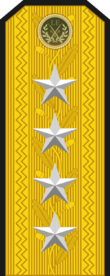 |

|
Ordinary and Full Uniform
The Ordinary Uniform is worn both in service only for part-time units and both in service and out of service for permanent personnel. The jacket is in twill and has the form prescribed for the Army, with black buttons which have the "RSI" cyphers. The neck is opened and black cloth-trimmed, adorned with the relevant insignia. The hand guards are red. The four pockets are of patch-type, with central torch and flaps. The shoulder boards bear the rank insignia.
The shirt is black and his tie is in black rayon. The trousers are riding short pants, with double black stripes; also long trousers without bands are provided. The cap is in grey-green twill fabric and bears the frieze of the Militia; alternatively is worn the fez of the Legion. Finishing touches: blacks boots with spurs or shoes depending on the type of used trousers and black leather gloves.
In winter the Legionnaire wears the mantle of black fabric, with the same cut prescribed for Army officers, that is up to 20 cm long below the knee, double-breasted and closed by a double row of three large buttons silver; the two slit pockets are closed by the same number of fins and, for officers, below the left side there is an opening to allow the passage of the pendants of the flakes of the garnet red officer scarf which is always worn over the jacket.
The Full Uniform is based on the Ordinary Uniform, with the adding of some items, namely the officer scarf, the black belt (with golden trims for officers) and the Squadrist dagger.
Service Uniform
The Service Uniform (It: Uniforme di Servizio) consists of a pattern simpler than the Ordinary Uniform; this is the most common uniform and it is widely used. All personnel wear black cargo trousers, black shirt and black infantry combat boots. The shirt may be long or short sleeved according the season, and has two patch-style breast pockets; the winter shirt is in heavy wool specifically treated. Under ordinary circumstances the cap which is used is the beret, but if required by the situation also the helmet can be worn.
Units deployed in mountain areas with particularly cold climates use a black sweater instead of the black shirt, and wind-breaker jacket with heavy internal lining. The sweater can replace the shirt even in public order, patrolling, manhunts and round-ups services.
Equipment
The lauwiner Empire Legion on its own (separated from the Empire Intelligence) has both civilian and military equipment for the fulfilment of its duties. Most of the heavy equipment is not owned by the Lauwiner Empire Legion but more rented in different sets for each specific operation or strike. Following equipment is standard operation equipment used worldwide.
Small Arms
| Model | Image | Caliber | Type | Origin | Details | |
|---|---|---|---|---|---|---|
| Pistols | ||||||
| G7 | 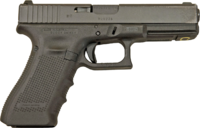 |
9×21mm | Pistol | Austria | Standard issue sidearm. | |
| M9 |  |
9×21mm | Pistol | Italy | Limited use by officers and special forces. | |
| Submachine Guns | ||||||
| MP5 | 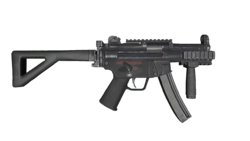 |
9x21mm | Submachine gun | Germany | Used by military police. | |
| P90 |  |
5.7x28mm | Submachine gun | Belgium | Used in night operations, close quarters, hostage rescue, and escort. | |
| MP7 | 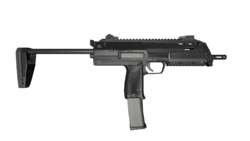 |
4.6x30mm | Submachine gun | Germany | Used by special forces. | |
| Shotguns | ||||||
| AA-12 | 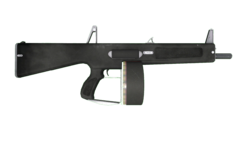 |
12 Gauge | Shotgun | U.S.A | ||
| M1014 | 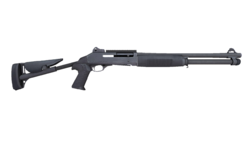 |
12 Gauge | Shotgun | Italy | ||
| Assault Rifles and Carbines | ||||||
| M5 |  |
5,56×45mm NATO | Assault rifle | U.S.A | Standard service rifle. | |
| M5C |  |
5,45×39mm | Carbine | USSR | Used in Operations China and Eastern | |
| Machine Guns | ||||||
| MG 4 | 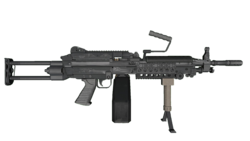 |
5.56x45mm | Light machine gun | Germany | Limited use, replaced by the M200. | |
| M240 |  |
5.56×45mm NATO | General-purpose machine gun | Belgium | ||
| M2 |  |
12.7x99mm | Heavy machine gun | U.S.A | Often mounted on vehicles or tripods. | |
| DMRs and Sniper Rifles | ||||||
| M200 |  |
.408 Cheyenne Tactical | Sniper rifle | U.S.A | ||
| M82 |  |
.50 BMG | Anti-materiel rifle, sniper rifle | U.S.A | ||
| Grenade-Based Weapons | ||||||
| M67 |  |
Fragmentation grenade | U.S.A | |||
| M18 | 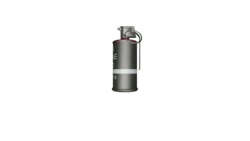 |
Smoke grenade | U.S.A | |||
| M84 | 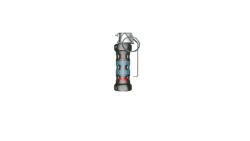 |
Flashbang | U.S.A | |||
| Portable Anti-Materiel Weapons | ||||||
| AT4 | |
HEAT | Anti-tank weapon. | Sweden | Light anti-vehicle weapon. | |
Artillery
| Model | Image | Caliber | Origin | Numbers | Details | |
|---|---|---|---|---|---|---|
| Mortars | ||||||
| M224 | 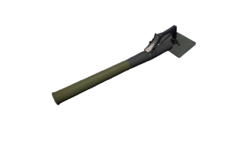 |
60mm | |
Unknown | ||
| M6 Mortar | 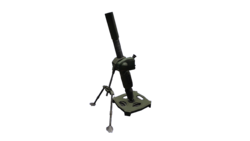 |
82mm | |
Unknown | ||
| Howitzers | ||||||
| M4 Scorcher | 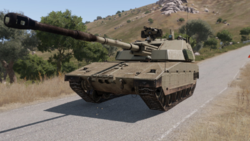 |
155mm self-propelled howitzer | |
Unknown | ||
| M119 | 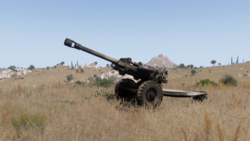 |
105mm howitzer | |
Unknown | ||
| Rocket Artillery | ||||||
| M5 Sandstorm | 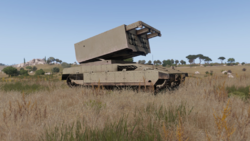 |
230mm self-propelled rocket artillery | |
Unknown | Self-propelled armoured multiple launch rocket system. | |
| Air Defence | ||||||
| HMMWV Avenger | 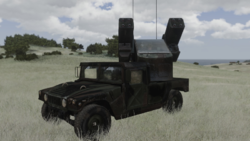 |
|
Unknown | |||
| M6A Cheetah | 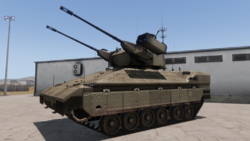 |
|
Unknown | Self-propelled armoured anti-aircraft vehicle. | ||
| M163A1 VADS | 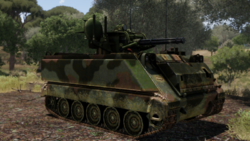 |
|
Unknown | Self-propelled anti-aircraft vehicle. Retired. | ||
| NASAMS | 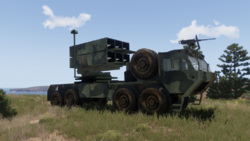 |
|
Unknown | Medium-long range air defence system. | ||
| C-RAM | 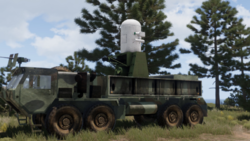 |
|
Unknown | Trailer-mounted version of the Praetorian 1C. | ||
| MIM-104 Patriot | 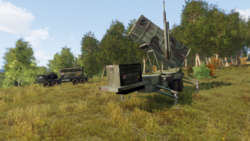 |
|
Unknown | Mobile, long range surface-to-air missile with anti-ballistic missile capability. | ||
Vehicles
| Model | Image | Origin | Numbers | Details | ||
|---|---|---|---|---|---|---|
| HMMWV | 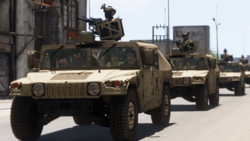 |
|
Unknown | Mostly replaced by the Hunter MRAP. Undergoing final phases of retirement. | ||
| Trucks | ||||||
| HEMTT | 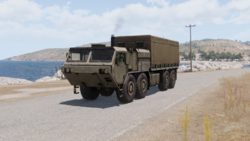 |
U.S.A | Unknown | |||
| MTVR | 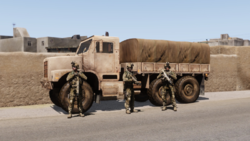 |
U.S.A | Unknown | |||
| Armoured Vehicles | ||||||
| M1 Abrams | 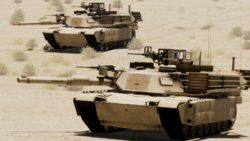 |
U.S.A | Unknown | Only rented, not owned | ||
| M1117 ASV | 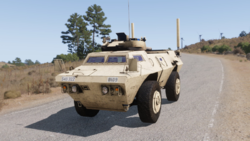 |
U.S.A | Unknown | |||
Aircraft
Attire
| Current attire | |||||
|---|---|---|---|---|---|
| Name | Pattern name(s) | Pattern | Image | Notes | |
| Army Combat Uniform (ACU) | Multiple Terrain Pattern (MTP) or Multiple Terrain Pattern - Tropic (MTP-T) |
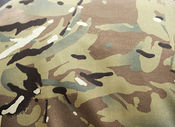 
|
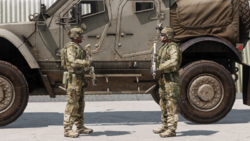 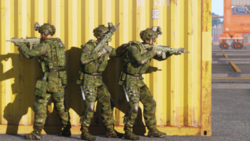
|
MTP is the standard camouflage for most deployments and is effective in a wide range of environments. It replaced several older camouflages as the standard for the Ironian Federal Army.
See alsoNotes and references<references /> |
|

